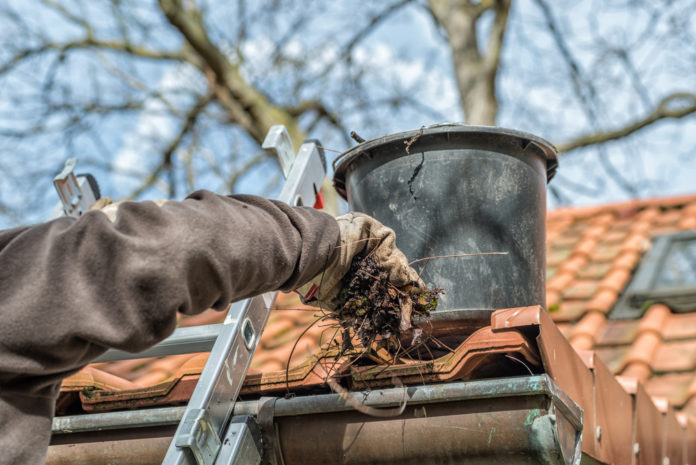Who else is enjoying this beautiful Fall weather we’re having? If it would only last, but alas, we know it will not. The leaves are starting to fall, and it won’t be long before the temperatures turn much cooler and the possibility of winter weather events increases.
That’s why we’re sharing with you the things you probably want to pay attention to in order to have your home and your landscape best prepared. Tackling a few Fall home maintenance items NOW can help ward off issues later, possibly preventing costly (and potentially dangerous) damage to your home.
Most of the tasks listed below are well within the average homeowner’s ability. But if you’d rather hire a professional to handle them, it can be well worth the expense. At F.C. Tucker Emge, we have a list of recommended resources for hiring out these tasks. Just get with your favorite Tucker real estate agent to find the best.
1. Clean your gutters.
Your roof’s drainage system diverts thousands of gallons of water yearly from your home’s exterior and foundation walls, so it’s vital to keep this system flowing smoothly. Clogged gutters can lead to damaged exterior surfaces and water in your basement. They are also more prone to rust and corrosion. Before the leaves fly this Fall, clean your gutters, then cover them with mesh gutter guards to keep debris from returning.
2. Seal air leaks.
Gaps in caulk and weatherstripping let cold air into your warm home, and sealing a drafty home can save up to 20% on your heating bills, according to the U.S. Department of Energy.
Weatherstripping is easily the most cost-effective way, but it can deteriorate over time. Try these two tests to see if it needs to be replaced:
- Try closing a door or window on a strip of paper. If the paper slides easily, your weatherstripping probably needs to be replaced.
- Close the door or window and hold a lighted candle near the frame (Don’t let the flame get near anything flammable!). If the flame flickers at any spot along the frame, you have an air leak.
You’ll also want to check for missing or damaged caulk around windows, doors, and entry points for electrical, cable, phone, and gas. Seal any gaps with a suitable caulk. If drafts around windows persist, consider getting your windows replaced. An investment in a more efficient window can decrease your heating bills.
3. Inspect your roof.
If you think you have some roof issues, address them now. Start by inspecting your roof from top to bottom, using binoculars if necessary. Check ridge shingles for cracks and wind damage. Look for damage to metal flashing in valleys and around vents and chimneys. Scan the entire roof for missing, curled, or damaged shingles. Look in your gutters for large accumulations of granules, a sign that your roof is losing its coating.
4. Protect faucets from freezing temperatures.
Make sure your outside faucets and in-ground irrigation systems don’t freeze and burst. First, close any shut-off valves serving outside faucets, then open the outside faucet to drain the line. If you don’t have shut-off valves, and your faucets are not “freeze-proof”, you might benefit from styrofoam faucet covers that are sold at many home centers.
To freeze-proof an in-ground irrigation system, follow the manufacturer’s procedure for draining it and protecting it from winter damage.
5. Freshen your furnace filter.
Clogged filters make it harder to keep your home at a comfortable temperature, and can increase your utility bills. Simple monthly cleaning is all it takes to keep these filters free of debris. Disposable filters can be vacuumed once before replacement. Foam filters can also be vacuumed, but they don’t need to be replaced unless they are damaged. Use the soft brush attachment on your vacuum cleaner. If the filter is metal or electrostatic, remove it and wash it with a firm water spray.
6. Give your furnace a checkup.
Once a year, it’s a good idea to have your heating system inspected by a professional. Don’t wait too long to schedule, though, as the heating pros tend to be busy this time of year. If you experience any of the following, don’t wait to call in for service:
- Noisy belts: Unusual screeches or whines could be a signal that belts connected to the blower motor are worn or damaged.
- Poor performance: Your heating ducts might be blocked, the burners might be misadjusted, the blower motor could be on its last legs, or maybe the furnace filter just needs to be cleaned.
- Erratic behavior: This could be caused by a faulty thermostat or a misadjusted furnace.
7. Ready your fireplace.
Even if you use your fireplace only occasionally, you should check it annually for damage and hazards. For most people, the best option is to have your entire chimney system inspected by a chimney sweep.
If you choose to inspect it on your own, shine a bright flashlight up the flue and look for any deposits approaching 1/8 inch thick. These deposits of creosote should be cleaned by an experienced chimney professional, as too much accumulation can result in a devastating fire.
Birds find chimneys great nesting spots, so if you don’t have a cap installed, you might consider it to prevent future unwanted tenants.
Finally, check the metal plate that opens and closes the flue (the damper), to ensure it moves properly.
8. Use a humidifier.
A humidifier in your home will help you feel more comfortable, by preventing dry sinuses and skin and also keep the wood in your home from cracking. Use distilled water as it is largely free of minerals and other materials that may leave deposits and release particles into the air. Make sure you read the label, though, as not all bottled waters are distilled.
If your home features a whole-house humidifier, follow the manufacturer’s instructions for maintenance and cleaning.
9. Ward off gas problems.
Keeping a gas heater in good shape is both a safety and a cost issue. An improperly maintained heater can spew toxic gases into the air of your home, or it could simply be costing you more to operate. Have a professional check these devices annually.
10. Repair walkways.
Damaged walkways, drives, and steps are a hazard year-round, but their dangers are compounded when the weather turns icy. Fixing issues in the Fall is also critical to preventing little cracks from becoming expensive headaches.
Look for cracks more than 1/8-inch wide, uneven sections, and loose railings on steps. Check for disintegration of asphalt or washed-out materials on loose-fill paths. Most of these issues can be fixed by the homeowner, but larger ones should be left to the professionals.
11. Prep your lawn for winter.
Raking leaves and aerating will prevent your lawn and garden beds from suffocating. Fertilizing and winterizing grass, trees, and shrubs will allow your greenery to enter its winter slumber comfortably and properly nourished.
12. Touch up exterior paint.
Fall offers plenty of days that are warm enough to work with exterior paint, and a touch-up can help prolong the life of your siding and trim. A fresh coat of paint or sealer on any surface that potentially will be covered with snow, such as porch stairs or wood floors, also is a wise idea.
Sooner is better to contact a local painter or attempt the project yourself, as many paints aren’t recommended for application on days when the temperature will dip colder than 45 to 50 degrees.

For all of the latest information on our local real estate market in Southwestern Indiana, you can always trust the professionals at F.C. Tucker Emge. Our agents have superior training and resources at their disposal to better educate you about the road to homeownership. Even if you are 6-12 months (or more!) out from making a change, there is a lot to learn about the home buying and selling process, and our agents can help you learn what you need to know so that you can be confident in your decision and have a smooth experience when the time comes. Let’s Talk!




